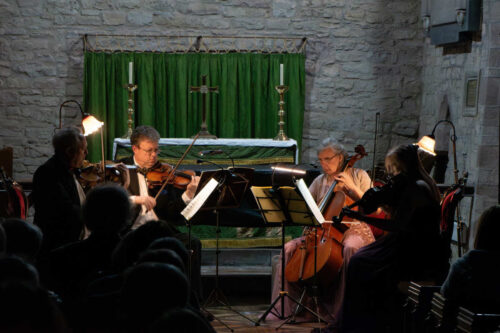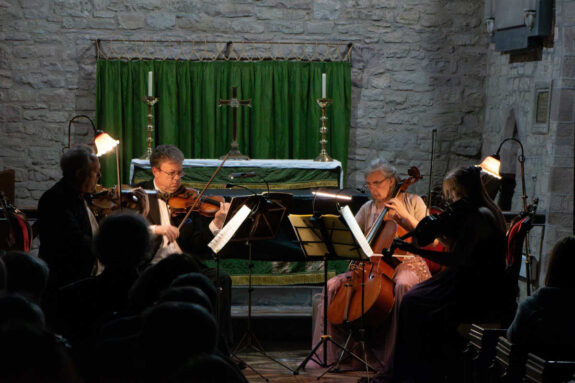 United Kingdom Corvedale Festival 2024 [1] – Various: Jarualda Quartet: (Alex Postlethwaite, David Joyce [violins], Jane Park [viola], Ruth Henley [cello]), Roelof Temmingh (piano); Magdalenna Krstevska (clarinet), Hamish Brown (piano), Cristian de Sá (violin), John Lenehan (piano). St. Michael’s Church, Munslow & St. Peter’s Church, Diddlebury, 20 & 21.9.2024. (CK)
United Kingdom Corvedale Festival 2024 [1] – Various: Jarualda Quartet: (Alex Postlethwaite, David Joyce [violins], Jane Park [viola], Ruth Henley [cello]), Roelof Temmingh (piano); Magdalenna Krstevska (clarinet), Hamish Brown (piano), Cristian de Sá (violin), John Lenehan (piano). St. Michael’s Church, Munslow & St. Peter’s Church, Diddlebury, 20 & 21.9.2024. (CK)

Schubert – Quartettsatz
Shostakovich – String Quartet No.3
Dvořák – Piano Quintet in A
Corvedale is a gentle valley, sparingly dotted with villages, in the lee of Wenlock Edge in Shropshire. Paul Henley, composer, erstwhile opera singer and passionate believer that classical music should be live and local, has founded a festival here with his cellist wife Ruth: the Festival is now in its third year, and I have been privileged to spend some time in this beautiful part of the country and to enjoy great music. The concerts take place in local churches – seven of them, each one beautiful and distinctive, from the ample Parish Church of St. Michael, Munslow to the tiny Broadstone Chapel in the middle of a field. Festivalgoers are thus guaranteed a rewarding architectural and topographical tour, included in the price of their tickets. Also included is an excellent buffet at most concerts: a seasoned festivalgoer remarked that of all the festivals he attends Corvedale is the best catered!
The opening concert was given by the Festival’s Artists-in-Residence, the Jarualda Quartet, four local professional musicians with busy careers in music and beyond (the viola player is also a chartered Educational Psychologist); Paul’s wife Ruth is the cellist. Their generous and demanding programme – three absolute masterpieces – provided the richest and most absorbing chamber music concert I can remember.
Schubert’s Quartettsatz can put one in two minds: disappointment that the composer, for some unfathomable reason, only wrote this one movement of a projected string quartet; or gratitude for the quality of the movement we have. When it is performed as it was here, we all move smartly into the latter camp: not least because it is so clearly among Schubert’s greatest music, and acts as a gateway to the masterpieces to come. That simple, soaring phrase that follows the busy opening lifted us gently off the ground, as Schubert’s melodies so often do.
Shostakovich’s String Quartet No.3 is one of his longest, lasting over half an hour. Shostakovich wrote 15 symphonies and 15 string quartets, but they do not march in step: when he composed this quartet, just after the war, he had recently composed Symphonies 8 and 9. Like them, it has five movements; and in some respects – certainly not in all – it seems to me to echo the atmosphere and the emotional trajectory of the Eighth Symphony (Shostakovich’s finest, for my money).
In his fine and thoughtful introduction, Alex Postlethwaite (Violin I) was right to stress its contemporary relevance – its eternal relevance, one fears – inviting us to call to mind the conflicts in Ukraine, Gaza, Myanmar and less reported places around the globe. He was also right to remind us that Shostakovich’s music very often has a subtext, a coded message: something that creates a sense of unease – a powerful element in the impact his music has on us.
This was very much the case in the Jarualdas’ performance. In their hands, the apparently harmless opening movement sounded rather sinister, like a clockwork toy which, at any moment, might run down or run out of control; and in the next two movements grotesquerie and violence were never far away. The fourth movement, like its counterpart in the Eighth Symphony, is a passacaglia, reaching the extremes of agony and despair; in the Jarualdas’ hands the very quiet music was sustained at a level of intensity that made it as powerful as the outbursts of grief – perhaps more so. A slithering cello ushers in the finale, a tense succession of musics which the players have to negotiate before finding an ambiguous and provisional calm beyond them.
I think we were all rather shaken by the performance: a tribute to Shostakovich, of course, but more particularly to the unflinching focus and intensity of the Jarualda Quartet’s playing.
Which of the great composers would you most like to meet? If the character of his music is anything to go by, Dvořák might well top my list. His Piano Quintet in A major is a marvellously characteristic piece, its forty minutes a challenge for the players, an unceasing delight for the audience. Dvořák’s gift for melody yields little or nothing to Schubert’s: the gentle arc of the opening cello phrase washes the soul. And so on, through the Dumka contrasts of the Andante, the lively Scherzo with its lovely Trio and the joyous energy of the finale. The Jarualdas were joined for this performance by the young South African pianist Roelof Temmingh: the restrictions of space in the chancel meant that the piano had to be placed behind the string players, seemingly rather remote from the audience: but Dvořák does not give the piano a starring role – the pianist is not even primus inter pares: he is a part of the music’s conversation, and in Temmingh’s hands a consistently poetic and delightful one.
Ross Edwards – Binyang
Elizabeth Maconchy – Fantasia
Miriam Hyde – Sonata for Clarinet and Piano
Brahms – Sonata in E flat for Clarinet and Piano
Saturday lunchtime brought a recital by the personable Australian clarinettist Magdalenna Krstevska, accompanied by the versatile London-based pianist Hamish Brown: their apparent youthfulness belies their wealth of musical experience in Britain and abroad. They began with Ross Edwards’s Binyang, a wonderfully freewheeling fantasia on Australian birdsong: for sluggards like me it would be the perfect morning wake-up call. Hamish accompanied discreetly on a small pair of claves – his percussion debut, Magdalenna informed us.
Elizabeth Maconchy’s substantial Fantasia bore out her words, quoted for us by Magdalenna, that ‘the best music is an impassioned argument’. It also bore out Maconchy’s rejection of English Pastoral in favour of European Modernism, though this did not preclude lyricism: piano and clarinet reached an almost tender accord before a chirpy, high-spirited section supervened. Magdalenna and Hamish’s colourful performance gave fresh impetus to my intention to explore Maconchy’s string quartets – shamefully, not yet acted upon.
I am grateful to these artists for introducing me to the impressive career and music of Australian composer Miriam Hyde. Her Sonata for Clarinet and Piano is another substantial piece, in three movements. Magdalenna’s suggested movement titles were very helpful – especially the first, ‘Journey by Sea’: the clarinet was gently borne along on rippling waves on the piano, becoming stormy before calming again. The colourful and varied second movement grew from an initial, rather Finzi-like pastoral vein; the finale brought real virtuosity from both players and a dazzling finish.
‘We both adore it’, said Hamish of Brahms’s E-flat Sonata, fruit of the composer’s late harvest of works written for his clarinettist friend Richard Muhlfeld: almost the last music he wrote. I shall not attempt to describe it: it was gorgeous, and it brought this substantial concert – well over an hour of continuous music – to an uplifting end.
Brahms – Scherzo in C minor; Violin Sonata No.2 in A major
Ravel – Sonate Posthum
Paul Henley – Recitative and Aria (world premiere)
R. Strauss – Sonata in E-flat
Saturday evening’s music for Violin and Piano – played by the young and elegant Portuguese violinist Cristian de Sá and John Lenehan – brought, at its heart, a warmly affectionate performance of Brahms’s golden A major Violin Sonata, and also my first taste of Paul Henley’s music: the world premiere of a compelling Recitative and Aria, dedicated to these two performers. Intriguingly, it also brought three pieces by famous composers before they were famous – all three of them aged 20 or so when they wrote them.
We began with the young Brahms’s vigorous contribution (a Scherzo) to a composite sonata for Joachim organised by Robert Schumann. Ravel’s first attempt at a Violin Sonata was subtler, and musically fascinating: we can hear the influence of Franck and Faure on the young composer, but also – especially in the consistently lovely piano part – hints of the composer-to-come of Ma mere l’Oye. Such pieces are sometimes dismissed as ‘transitional’; but this, in this performance, was entirely winning.
The recital ended with Richard Strauss’s early Violin Sonata: hugely entertaining, as we might expect, full of the bounding energy, the boundless confidence – arrogance, even – of youthful genius. It was written, as the programme note reminded us, at the time when Schumann and Mendelssohn were being shouldered out of Strauss’s personal pantheon by Liszt, Berlioz and Wagner: Don Juan was just around the corner. It was great fun to try spotting clues: the Alpine Symphony’s cascading waterfall (early on), perhaps the Der Rosenkavalier Prelude in the piano’s ebullient introduction to the third movement; possibly, in the violin’s grand lyrical tune later in the movement, a great aria for his future wife Pauline to sing (Strauss first met her in 1887, the year of this sonata: I wonder if that has any bearing on the case?).
A great recital, rightly rewarded with a standing ovation. And plenty of music to come!
Chris Kettle
